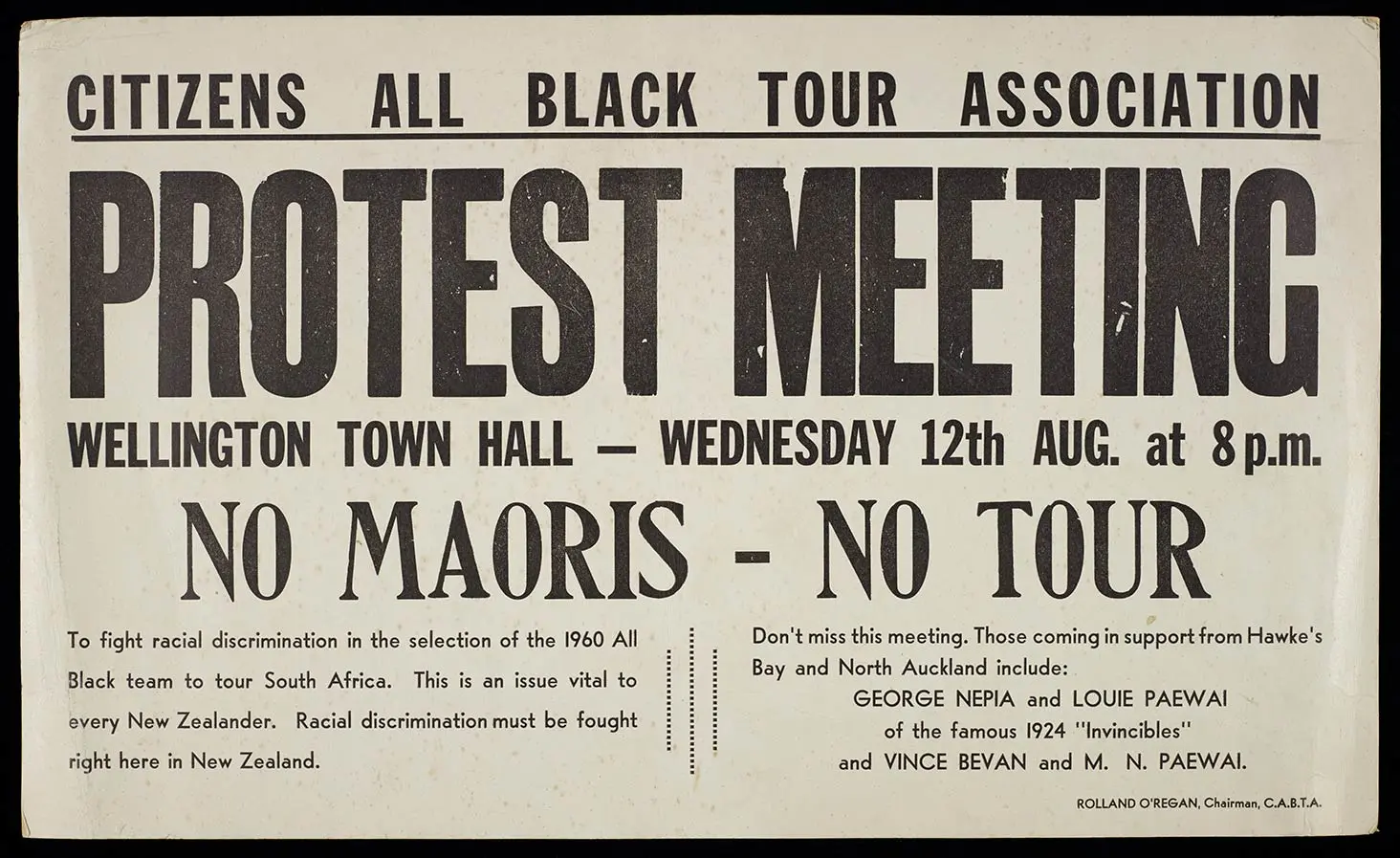Image credit: Publicity for a ‘No Maoris — No Tour’ protest meeting, Wellington, 1959 by Citizens All Black Tour Association. Ref: Eph-D-RACIAL-1959-01 Alexander Turnbull Library.

Image credit: Publicity for a ‘No Maoris — No Tour’ protest meeting, Wellington, 1959 by Citizens All Black Tour Association. Ref: Eph-D-RACIAL-1959-01 Alexander Turnbull Library.

From the middle of last century, there was growing protest in Aotearoa New Zealand over Māori playing for the All Blacks being excluded from touring South Africa. Find out more by exploring our collections and curated resources.
It's easy to glance at pictures of the 1981 Springbok tour of New Zealand and see them as interesting moments of protest. Old photographs of thousands of angry New Zealanders bashing each other hardly compare with the gore of today's live-streamed violence. It's easy, therefore, to forget what it was all about: apartheid, white supremacy and the 50-year ban on Māori or any other ‘coloured’ player from South African rugby fields, dating from the first All Blacks tour of South Africa in 1928.
The response of the New Zealand Rugby Football Union (NZRFU) in 1928 was simple: leave the Māori players at home, which is why rugby legend George Nēpia was not among the team. The next All Blacks tour of South Africa was in 1949, by which time apartheid was government policy there. As a result, Johnny Smith, Ron Bryers, Ben Couch and Vincent Bevan — all Māori, all All Blacks — were excluded from selection by the NZRFU. A section of the New Zealand public was getting distinctly toey about the situation.
By 1959, with another All Blacks tour of South Africa scheduled for the following year, some New Zealanders began to mobilise. The Citizens All Black Tour Association campaigned against the expected racially based team selection. ‘No Maoris — No Tour’ became a catchcry. More than 150,000 New Zealanders signed a petition protesting the NZRFU's compliance with South Africa's all-white requirement. The tour went ahead anyway. A decade later, the New Zealand protest group Halt All Racist Tours (HART) was established.
A scheduled All Blacks tour to South Africa was cancelled in 1967 in the face of increasing pressure. In 1970, the South Africans allowed a racially mixed team of All Blacks to tour, with three Māori players and one Samoan classified as ‘honorary whites’. The idea that any players had to be classified as ‘honorary whites’ to gain acceptance in South Africa was anathema to many Kiwis. The stage was set for the Springbok Tour of New Zealand in 1981, with its violent division between those who felt politics had no place in sport, and those repulsed by their country's complicit support for South African racism.
Today, it is impossible to imagine a New Zealand national rugby team that deliberately excludes Māori and Pasifika or anyone else on the basis of colour or ancestry. But that's how it was. And not that long ago.
The Turnbull Library holds the HART archive, as well as the photographic archive of Crown Studios. The latter includes portraits of All Blacks and rugby luminaries dating from the 1920s to 1977.
Story written by: Chris Szekely
Copyright: Turnbull Endowment Trust
Image credit: George Nēpia, 1924 by Crown Studios Ltd. Ref: 1/2-204815-F Alexander Turnbull Library.

George Nēpia, one of New Zealand's first internationally renowned sporting stars, was a member of the All Blacks touring team ‘The Invincibles’ in 1924. He was overlooked for selection for the first All Blacks tour of South Africa in 1928. He was a speaker at the meeting advertised in the handbill here.
Read a connected story from Te Kupenga: Halt the racist tour.
Explore the Alexander Turnbull Library collections further:
Topic Explorer has:
Many Answers has:
Want to share, print or reuse one of our images? Read the guidelines for reusing Alexander Turnbull Library images.
Tikanga ā-iwi:
Te whakaritenga pāpori me te ahurea
Te ao hurihuri
Ngā mahinga ohaoha.
Te Takanga o Te Wā (ngā hītori o Aotearoa):
Whakapapa
Mana motuhake
Whanaungatanga.
Social sciences concepts:
Identity, culture, and organisation
Place and environment
Continuity and change.
Aotearoa New Zealand's histories:
Colonisation and its consequences
The exercise of power
Relationships and connections between people.